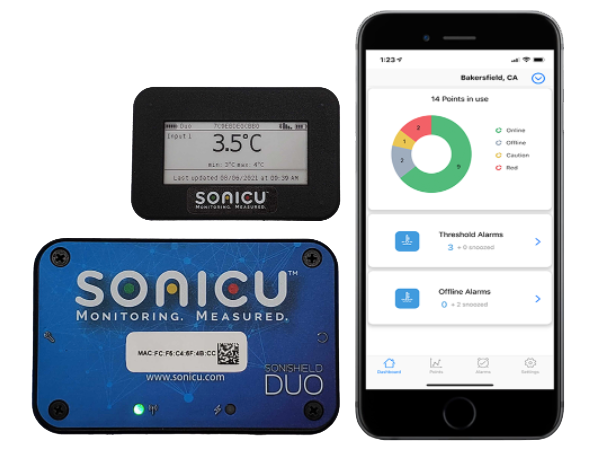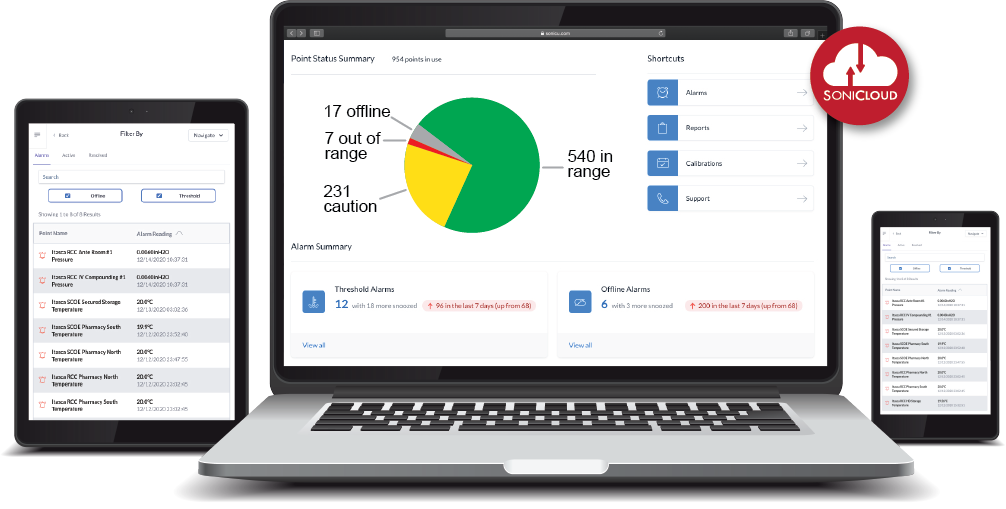Heat Stress Monitoring and Compliance
CAL OSHA Compliance For 2025 Heat Standards
Affordable Heat Stress Monitoring
- Plug and Play Installation: Be Online in Minutes
- App-based install wizard to guide easy install
- Simple alert set up to phone, text, app
- Powerful reporting to satisfy a snap inspection
- Trusted by more than 550 customers
- Live Customer Support and Free Unlimited Training
- Tiered Alarming To Connect Your Entire Staff
- Affordable, Proven and Ready to Protect Your Staff and Your Operations
CAL OSHA is aggressively inspecting indoor workspaces for costly heat stress violations.

Get an instant quote
Warehouse Monitoring
Warehouse Monitoring
By maintaining optimal conditions, the warehouse can prevent product damage, spoilage, or degradation, ensuring that customers receive goods in the best possible condition. Facilisi lacus amet fringilla nunc vulputate mi.
Compliance Automation
Cloud-based software platform allows management of multiple points and locations and documents temperatures and quality control for regulatory compliance.
We offer more than a year of data storage for your logs and our sensors are completely wireless, cost-effective, and easy to deploy.
Our alerting system is highly customizable, providing notifications via text, email, phone calls, and push notifications.
These alerts can be configured to repeat and escalate, ensuring that the appropriate personnel are promptly informed and can take necessary action.
Our sensors are compact, resembling hockey pucks in size and shape, and are IP67-rated for durability. They measure both ambient temperature and humidity, with our cloud-based software automatically calculating the heat index.
Our software also offers sophisticated multi-site management features, enabling you to efficiently oversee multiple divisions. Site managers can be granted access only to their specific areas, while corporate managers can monitor all locations and divisions from a centralized dashboard.
An additional feature that has been particularly popular with our manufacturing and warehouse clients is the ability to display heat index scores on large screens.
This provides frontline workers with real-time visibility of their work environment's conditions.
Furthermore, we offer a variety of reports that can be delivered to you via email at your preferred frequency. These reports range from detailed regulatory documents suitable for audits to managerial summaries that help identify areas requiring further training.
.png?width=1563&height=781&name=Sonicu%20Devices%20(1).png)
Cal/OSHA's Heat Illness Prevention in Indoor Places of Employment regulation applies to most indoor workplaces, such as restaurants, warehouses, and manufacturing facilities where temperatures can get high.
For indoor workplaces where the temperature reaches 82 degrees Fahrenheit, employers must take steps to protect workers from heat illness. Some of the requirements include providing water, rest, cool-down areas, methods for cooling down the work areas under certain conditions, and training.
Employers may be covered under both the indoor and outdoor regulations if they have both indoor and outdoor workplaces.
- A Person Designated to Oversee the Heat Illness Prevention Program
- Hazard Identification
- Water. Rest. Shade Message
- Acclimatization
- Modified Work Schedules
- Training
- Monitoring for Signs and Symptoms
- Emergency Planning and Response

Automated Regulatory Compliance
- Automated logging and reporting
- Long-Life Onboard Rechargeable Battery
- Redundancy rich: connectivity, data &
power protection comes standard - Satisfies federal and state OSHA policies for heat stress monitoring
- Instant regulatory report creation

Save Time With Operational Efficiency
- Reduced manual logging
- Instant regulatory report creation
- Modular design allows you to easily add more sensors
- Affordable subscription model
- Flexible Transmission via 4G, Radio Frequency, Wi-Fi & Ethernet




Get an instant quote
Why Has OSHA Issued A New Mandate?
It is particularly for workers employed for labor in warehouses, manufacturing facilities, and distribution centers.
If you’re in a leadership position at any of these types of facilities, please don’t take this new mandate lightly.
Sonicu was alerted to this new practice when two warehouse operators became customers AFTER they were cited by OSHA.
Back in June 2021, the Acting Assistant Secretary of Labor for Occupational Safety and Health Administration, Jim Frederick, announced that the agency was working on a new set of guidelines.
These new guidelines were linked to reported climate change trends detected over the last 18 years, some of the hottest years on record.
The increased intensity of heat waves has put the lives of many people at risk and the federal government is following the lead of a handful of states and municipalities which are taking this threat to employees very seriously.
From 2001 to 2019, rising temperatures in California alone resulted in approximately 20,000 workplace injuries, indoors and outdoors including.
Similarly in 2019, 43 workers died from heat illnesses while over 2400 suffered injuries from heat hazards at work. However, this number rose to 61 in 2021.
New heat waves are potentially damaging the productivity and output of businesses, alarming administrators and waking up regulators to a growing threat of heat stress at work, both indoors and outdoors.
According to the Atlantic Council’s Adrienne Arsht-Rockefeller Foundation Resilience Center, heat-related illnesses from the workspace have cost businesses at least $100 billion per year.
This rate is set to double by 2030.
It’s also important to note that while OSHA didn’t have any rulings on temperature and humidity in office settings.
Now with over 111 safety and labor groups, including the Public Citizen, legislators have been urged to create new federal standard guidelines that protect indoor (and outdoor) workers from heat-related illnesses.

Heat Stress Software Demonstration
Only Sonicu Can Offer Complete Monitoring and Compliance Solutions on One Platform
Sonicu's exclusive monitoring capabilities are unmatched. You get smarter alarm solutions, audit-ready reports in just a few clicks, and seamless integration with third-party systems so you can see it all under on dashboard.
Always On 24/7
SoniCloud is a secure, cloud-based platform that aggregates system-wide monitoring data to web-based dashboards, and includes a native iOS/Android mobile app to ensure 24/7 access to critical information.
Never Miss An Alarm Again
False alarms disrupt operations and cause unnecessary stress. Sonicu’s SMART Alarm Handler offers buffering features and tiered escalation to ensure critical alerts reach the right people until the issue is resolved.
No More Data Gaps
Avoid compliance headaches caused by missing data. Sonicu's system provides multiple layers of redundancy for maximum data security. Includes battery backup, cellular failover, and DataSync technology that automatically stores and forwards readings during a network or power outage.
No Local IT? No Problem!
Sonicu offers connectivity options fit to meet IT requirements with the flexibility to support enterprise installations. Choose from cellular (no IT-support needed), WiFi, Ethernet, or SoniLink LoRaWAN connectivity, with fail-over redundancy options.
Compliance with Calibration Regulations is a SNAP
Never worry about expired calibrations and certificates again. With Sonicu's SNAP calibration program, automatically receive ISO 17025 calibrated probes with easy-to-access digital certificates, to de-risk regulatory or SOP calibration compliance.
The Fast Path to Simpler Monitoring & Compliance
Sonicu offers preconfigured monitoring kits, mobile app-based setup tools, implementation wizards that walk you through installation, and even customizable project management services to get your system up and running quickly and efficiently.
Here for You, Every Step of the Way
Even after implementation, Sonciu is always in your corner. Sonicu Academy, our online help center, is packed with helpful articles, step guides, and even video tutorials for basic troubleshooting solutions. Our US-based Support Team has direct hands-on experience with Sonicu hardware, how to navigate the SoniCloud platform, and can quickly get the answers you need.
No Upfront Capital Required
You don't need to completely overhaul your current system to switch to Sonicu. We have flexible acquisition options to seamlessly integrate into existing SSO, BMS, and other workflow softwares that already work for you, so you can get connected fast while avoiding upfront capital requirements.
Definitions.
“Acclimatization” means temporary adaptation of the body to work in the heat that occurs gradually when a person is exposed to it. Acclimatization peaks in most people within four to fourteen days of regular work for at least two hours per day in the heat.
“Heat Illness” means a serious medical condition resulting from the body's inability to cope with a particular heat load, and includes heat cramps, heat exhaustion, heat syncope, and heat stroke.
“Environmental risk factors for heat illness” means working conditions that create the possibility that heat illness could occur, including air temperature, relative humidity, radiant heat from the sun and other sources, conductive heat sources such as the ground, air movement, workload severity and duration, protective clothing and personal protective equipment worn by employees.
“Landscaping” means providing landscape care and maintenance services and/or installing trees, shrubs, plants, lawns, or gardens, or providing these services in conjunction with the design of landscape plans and/or the construction (i.e., installation) of walkways, retaining walls, decks, fences, ponds, and similar structures, except for employment by an employer who operates a fixed establishment where the work is to be performed and where drinking water is plumbed.
“Oil and gas extraction” means operating and/or developing oil and gas field properties, exploring crude petroleum or natural gas, mining or extracting oil or gas, or recovering liquid hydrocarbons from oil or gas field gases.
“Personal risk factors for heat illness” means factors such as an individual's age, degree of acclimatization, health, water consumption, alcohol consumption, caffeine consumption, and use of prescription medications that affect the body's water retention or other physiological responses to heat.
“Shade” means blockage of direct sunlight. One indicator that blockage is sufficient is when objects do not cast a shadow in the area of blocked sunlight. Shade is not adequate when heat in the area of shade defeats the purpose of shade, which is to allow the body to cool. For example, a car sitting in the sun does not provide acceptable shade to a person inside it, unless the car is running with air conditioning. Shade may be provided by any natural or artificial means that does not expose employees to unsafe or unhealthy conditions and that does not deter or discourage access or use.
“Temperature” means the dry bulb temperature in degrees Fahrenheit obtainable by using a thermometer to measure the outdoor temperature in an area where there is no shade. While the temperature measurement must be taken in an area with full sunlight, the bulb or sensor of the thermometer should be shielded while taking the measurement, e.g., with the hand or some other object, from direct contact with sunlight.
